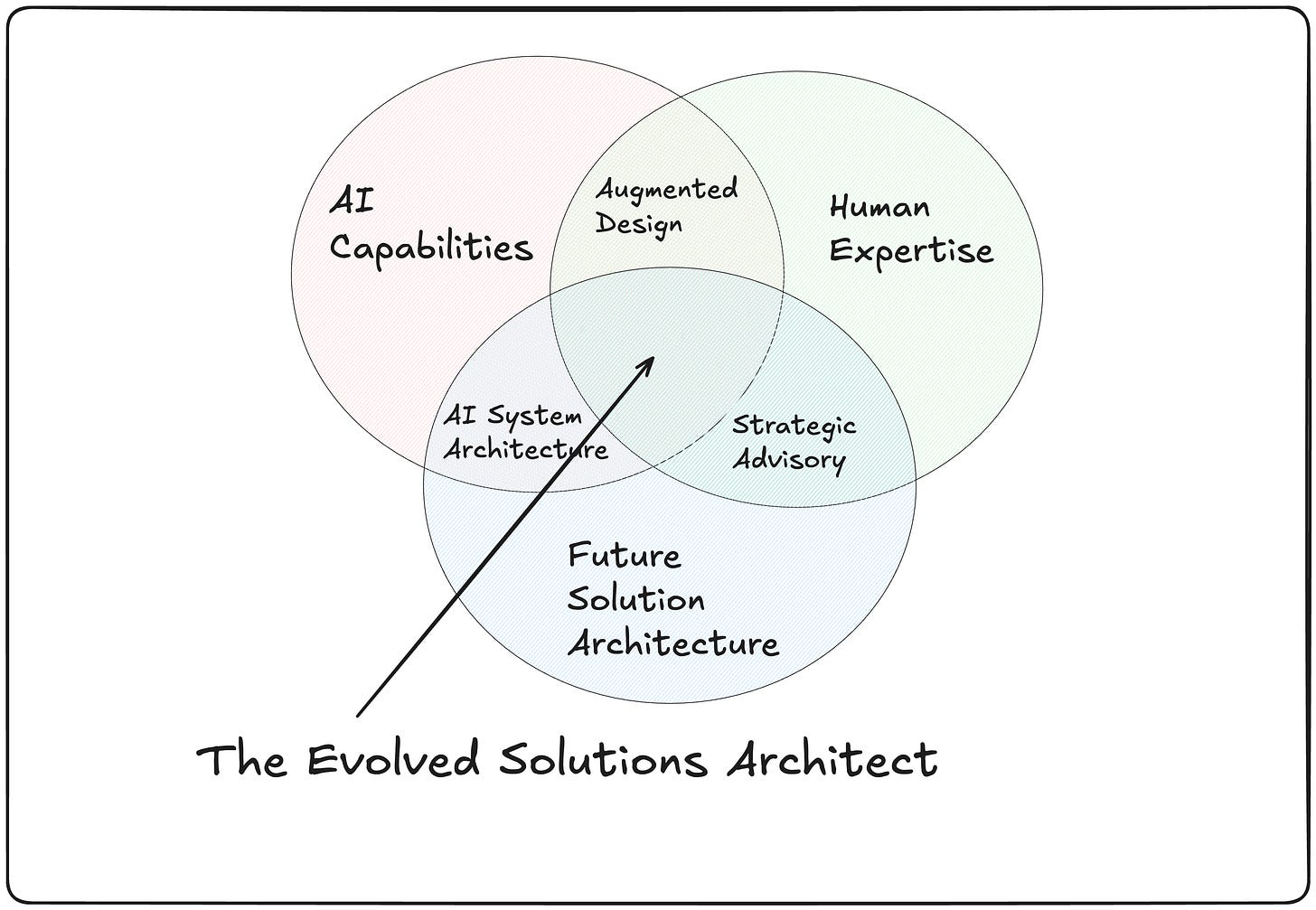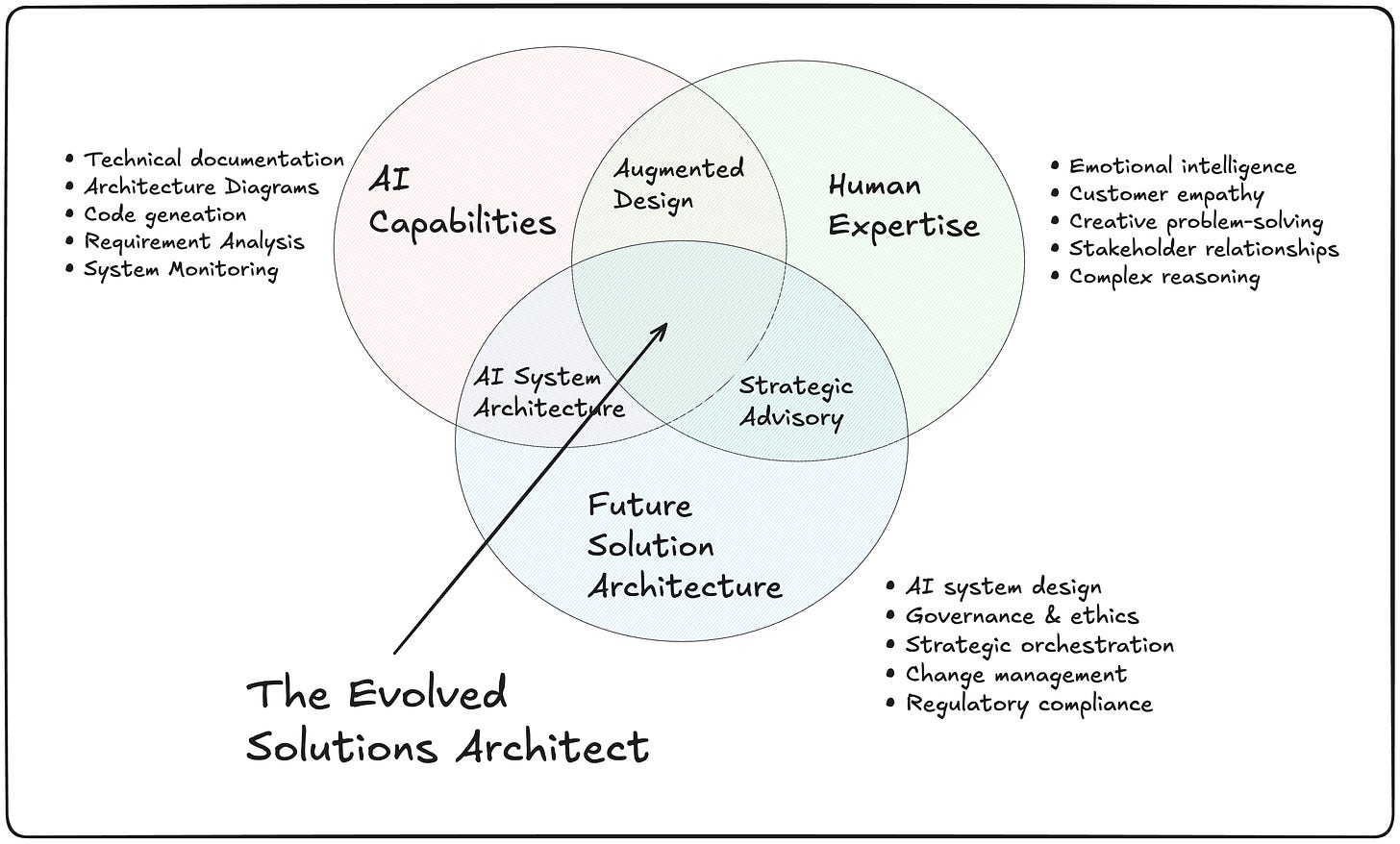The Future of Solutions Architect Role with Agentic AI
Hey, Prasad here 👋 I'm the voice behind the weekly newsletter "Big Tech Careers."
In this week's article, I explain how the role of a Solutions Architect evolves in the age of Agentic AI.
If you like the article, click the ❤️ icon. That helps me know you enjoy reading my content.
In my previous article about the strategic role Solutions Architects play in product launches, I touched on how AI will reshape our profession. The response was overwhelming - it's clear this topic strikes at the heart of what many of us are thinking about as we watch Generative AI and Agentic AI systems rapidly evolve.
Today, I want to dive deep into what I see as the most significant transformation our role will undergo in the next 5-10 years. Spoiler alert: we're not being replaced, we're being elevated - but only if we adapt strategically. The Solutions Architect role is about to become more critical than ever. But it's also about to fundamentally change.
🤖 Understanding the AI Revolution in Our Context
Before diving into how our role evolves, let's establish what we mean by Generative AI and Agentic AI in the Solutions Architecture context.
Generative AI in our world goes beyond chatbots and content creation. We're talking about systems that can generate technical documentation, create architectural diagrams, write integration code, and even design entire solution blueprints based on customer requirements. These capabilities directly intersect with traditional Solutions Architect activities.
Agentic AI represents an even more profound shift. These are AI systems that can take autonomous actions, make decisions within defined parameters, and orchestrate complex workflows. Imagine AI agents that can automatically provision cloud resources, configure networking, deploy applications, and monitor system health - all while adapting to changing conditions without human intervention.
The intersection of these technologies with Solutions Architecture creates unprecedented opportunities and challenges.
🎯 The Augmented Solutions Architect: From Manual to Strategic
The most immediate transformation will be in how we approach technical design and implementation. Instead of spending hours creating architectural diagrams, writing technical specifications, and documenting integration patterns, we'll increasingly work alongside AI systems that can handle these tasks at scale.
But here's where it gets interesting - and where many people misunderstand the implications. AI won't replace our judgment; it will amplify our impact. While AI can generate a technically sound architecture diagram, it takes human insight to understand the political dynamics of a customer's IT organization, the budget constraints that will influence technology choices, and the cultural factors that determine adoption success.
Solutions Architects who embrace AI tools are spending less time on routine technical tasks and more time on strategic customer engagement. They're not working less; they're working at a higher level.
The augmented Solutions Architect will become a strategic orchestrator, directing AI systems to handle routine technical work while focusing human effort on relationship building, creative problem solving, and navigating complex organizational dynamics.
🔄 From Solution Designer to AI System Architect
Perhaps the most significant evolution will be in how we think about solutions themselves. Traditional Solutions Architecture often involved designing relatively static systems - we'd create an architecture, implement it, and then maintain it over time.
In an AI-native world, we're increasingly designing dynamic, self-adapting systems. These solutions don't just execute predetermined workflows; they learn, adapt, and optimize themselves based on real-world performance data. This requires a fundamentally different approach to architectural thinking.
Solutions Architects will need to become experts in AI system design - understanding how to architect solutions that incorporate multiple AI agents, manage agent interactions, handle uncertainty and errors in AI decision-making, and ensure appropriate human oversight and control.
This shift demands new skills: understanding AI model capabilities and limitations, designing robust agent interaction patterns, implementing effective human-in-the-loop workflows, and creating monitoring systems that can detect when AI agents are operating outside their intended parameters.
🧠 The Human Elements That Become More Valuable
As AI handles more routine technical tasks, the uniquely human aspects of Solutions Architecture become exponentially more valuable. Emotional intelligence, creative problem-solving, and the ability to navigate complex stakeholder relationships can't be automated.
Customer empathy will become a core differentiator. While AI can analyze technical requirements and generate solution options, it takes human insight to understand the frustration behind a feature request, the organizational dynamics influencing a technology decision, or the career implications of a technical choice for a key stakeholder.
Complex reasoning and intuition will also become more critical. Solutions Architects often succeed by reading between the lines, identifying unstated requirements, and anticipating problems that aren't obvious from the stated specifications. These pattern recognition and intuitive capabilities remain distinctly human strengths.
The ability to build trust and credibility will become even more important as technical complexity increases. Customers will need Solutions Architects who can not only design AI-powered solutions but also explain them in terms that business stakeholders can understand and trust.
⚡ New Responsibilities: AI Governance and Ethics
The integration of AI into customer solutions brings entirely new responsibilities for Solutions Architects. We'll increasingly need to address questions about AI governance, ethical AI use, and responsible AI implementation.
This includes understanding regulatory requirements around AI usage, designing solutions that provide appropriate transparency and explainability, implementing bias detection and mitigation strategies, and ensuring that AI-powered solutions comply with industry-specific requirements.
Solutions Architects will need to become fluent in AI risk assessment, helping customers understand the implications of different AI implementation choices and designing governance frameworks that balance innovation with responsibility.
We'll also play a crucial role in AI change management, helping organizations understand how AI-powered solutions will impact their workflows, job roles, and operational processes. This human-centered approach to AI implementation will become a key differentiator.
🔮 The Evolution Timeline: What to Expect
In the next 2-3 years, I expect we'll see AI tools becoming standard parts of the Solutions Architect toolkit. Early adopters are already using AI for generating technical documentation, creating proof-of-concept code, and analyzing customer requirements. This will become universal.
The 3-5 year horizon is where things get really interesting. We'll start seeing AI agents that can handle routine customer interactions, automatically generate solution proposals, and even manage certain aspects of implementation projects. Solutions Architects who haven't adapted will find themselves at a significant disadvantage.
Looking 5-10 years out, I believe we'll see the emergence of truly autonomous AI systems that can handle many traditional Solutions Architecture tasks end-to-end. But rather than eliminating our role, this will push successful Solutions Architects into even more strategic positions - acting as AI orchestrators, customer relationship managers, and strategic advisors.
🎪 Preparing for the AI-Native Future
So how do we prepare? First, start experimenting with AI tools today. Don't wait for your organization to mandate their use. The Solutions Architects who are already comfortable with AI workflows will have a massive advantage as these tools become more sophisticated.
Second, double down on the human skills that will become more valuable. Invest in developing your emotional intelligence, communication skills, and strategic thinking capabilities. These will be your differentiators in an AI-augmented world.
Third, begin developing expertise in AI system architecture. You don't need to become a machine learning engineer, but you should understand how AI agents work, how to integrate AI capabilities into traditional systems, and how to design solutions that leverage AI effectively.
Finally, start thinking about AI governance and ethics in your current role. Begin building expertise in responsible AI implementation, understanding regulatory requirements, and helping customers navigate the ethical implications of AI adoption.
🌟 The Opportunity Ahead
The evolution of AI represents the biggest transformation in Solutions Architecture since the move to cloud computing. It will eliminate some traditional activities, create entirely new responsibilities, and elevate the strategic importance of our role.
Those who embrace this change and develop the new skills required will find unprecedented opportunities for career growth and impact. Those who resist or ignore these trends risk becoming irrelevant.
The future Solutions Architect will be part technologist, part strategist, part counselor, and part AI orchestrator. It's a challenging evolution, but also an incredibly exciting one.
The organizations that recognize this transformation early and invest in developing AI-native Solutions Architecture capabilities will have a significant competitive advantage. The individual Solutions Architects who embrace this future will find themselves at the center of their organization's most strategic initiatives.
The question isn't whether AI will transform our role - it's whether we'll lead that transformation or be left behind by it.
If you enjoyed the read, click the ❤️ icon. That helps me know you enjoy reading my content. See you all next week with another article!




Prasad, Thank you for sharing the great insights on the future of solution architecture role with agentic AI. I liked the most on section " The evolution timeline : What to expect". It will be good if you could share some practical implementation references to the 2-3 years horizon specially focussing on SDLC automation.